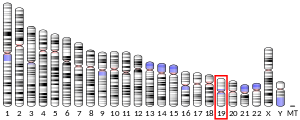RNA polymerase II elongation factor ELL is an enzyme that in humans is encoded by the ELL gene.[5][6][7]
Interactions
editReferences
edit- ^ a b c GRCh38: Ensembl release 89: ENSG00000105656 – Ensembl, May 2017
- ^ a b c GRCm38: Ensembl release 89: ENSMUSG00000070002 – Ensembl, May 2017
- ^ "Human PubMed Reference:". National Center for Biotechnology Information, U.S. National Library of Medicine.
- ^ "Mouse PubMed Reference:". National Center for Biotechnology Information, U.S. National Library of Medicine.
- ^ Thirman MJ, Levitan DA, Kobayashi H, Simon MC, Rowley JD (Jan 1995). "Cloning of ELL, a gene that fuses to MLL in a t(11;19)(q23;p13.1) in acute myeloid leukemia". Proc Natl Acad Sci U S A. 91 (25): 12110–4. Bibcode:1994PNAS...9112110T. doi:10.1073/pnas.91.25.12110. PMC 45386. PMID 7991593.
- ^ Shilatifard A, Lane WS, Jackson KW, Conaway RC, Conaway JW (Apr 1996). "An RNA polymerase II elongation factor encoded by the human ELL gene". Science. 271 (5257): 1873–6. Bibcode:1996Sci...271.1873S. doi:10.1126/science.271.5257.1873. PMID 8596958. S2CID 46101044.
- ^ "Entrez Gene: ELL elongation factor RNA polymerase II".
- ^ Shinobu N, Maeda T, Aso T, Ito T, Kondo T, Koike K, Hatakeyama M (Jun 1999). "Physical interaction and functional antagonism between the RNA polymerase II elongation factor ELL and p53". J. Biol. Chem. 274 (24): 17003–10. doi:10.1074/jbc.274.24.17003. PMID 10358050.
Further reading
edit- Iwabuchi K, Bartel PL, Li B, Marraccino R, Fields S (1994). "Two cellular proteins that bind to wild-type but not mutant p53". Proc. Natl. Acad. Sci. U.S.A. 91 (13): 6098–102. Bibcode:1994PNAS...91.6098I. doi:10.1073/pnas.91.13.6098. PMC 44145. PMID 8016121.
- Maruyama K, Sugano S (1994). "Oligo-capping: a simple method to replace the cap structure of eukaryotic mRNAs with oligoribonucleotides". Gene. 138 (1–2): 171–4. doi:10.1016/0378-1119(94)90802-8. PMID 8125298.
- Shilatifard A, Haque D, Conaway RC, Conaway JW (1997). "Structure and function of RNA polymerase II elongation factor ELL. Identification of two overlapping ELL functional domains that govern its interaction with polymerase and the ternary elongation complex". J. Biol. Chem. 272 (35): 22355–63. doi:10.1074/jbc.272.35.22355. PMID 9268387.
- Suzuki Y, Yoshitomo-Nakagawa K, Maruyama K, Suyama A, Sugano S (1997). "Construction and characterization of a full length-enriched and a 5'-end-enriched cDNA library". Gene. 200 (1–2): 149–56. doi:10.1016/S0378-1119(97)00411-3. PMID 9373149.
- Shilatifard A (1998). "Identification and purification of the Holo-ELL complex. Evidence for the presence of ELL-associated proteins that suppress the transcriptional inhibitory activity of ELL". J. Biol. Chem. 273 (18): 11212–7. doi:10.1074/jbc.273.18.11212. PMID 9556611.
- Li XY, Green MR (1998). "The HIV-1 Tat cellular coactivator Tat-SF1 is a general transcription elongation factor". Genes Dev. 12 (19): 2992–6. doi:10.1101/gad.12.19.2992. PMC 317190. PMID 9765201.
- Shinobu N, Maeda T, Aso T, Ito T, Kondo T, Koike K, Hatakeyama M (1999). "Physical interaction and functional antagonism between the RNA polymerase II elongation factor ELL and p53". J. Biol. Chem. 274 (24): 17003–10. doi:10.1074/jbc.274.24.17003. PMID 10358050.
- Schmidt AE, Miller T, Schmidt SL, Shiekhattar R, Shilatifard A (1999). "Cloning and characterization of the EAP30 subunit of the ELL complex that confers derepression of transcription by RNA polymerase II". J. Biol. Chem. 274 (31): 21981–5. doi:10.1074/jbc.274.31.21981. PMID 10419521.
- Kim MK, Nikodem VM (2000). "hnRNP U inhibits carboxy-terminal domain phosphorylation by TFIIH and represses RNA polymerase II elongation". Mol. Cell. Biol. 19 (10): 6833–44. doi:10.1128/MCB.19.10.6833. PMC 84680. PMID 10490622.
- Lavau C, Luo RT, Du C, Thirman MJ (2000). "Retrovirus-mediated gene transfer of MLL-ELL transforms primary myeloid progenitors and causes acute myeloid leukemias in mice". Proc. Natl. Acad. Sci. U.S.A. 97 (20): 10984–9. Bibcode:2000PNAS...9710984L. doi:10.1073/pnas.190167297. PMC 27135. PMID 10995463.
- Simone F, Polak PE, Kaberlein JJ, Luo RT, Levitan DA, Thirman MJ (2001). "EAF1, a novel ELL-associated factor that is delocalized by expression of the MLL-ELL fusion protein". Blood. 98 (1): 201–9. doi:10.1182/blood.V98.1.201. PMID 11418481. S2CID 2577367.
- Luo RT, Lavau C, Du C, Simone F, Polak PE, Kawamata S, Thirman MJ (2001). "The elongation domain of ELL is dispensable but its ELL-associated factor 1 interaction domain is essential for MLL-ELL-induced leukemogenesis". Mol. Cell. Biol. 21 (16): 5678–87. doi:10.1128/MCB.21.16.5678-5687.2001. PMC 87288. PMID 11463848.
- Simone F, Luo RT, Polak PE, Kaberlein JJ, Thirman MJ (2003). "ELL-associated factor 2 (EAF2), a functional homolog of EAF1 with alternative ELL binding properties". Blood. 101 (6): 2355–62. doi:10.1182/blood-2002-06-1664. PMID 12446457.
- Polak PE, Simone F, Kaberlein JJ, Luo RT, Thirman MJ (2003). "ELL and EAF1 are Cajal body components that are disrupted in MLL-ELL leukemia". Mol. Biol. Cell. 14 (4): 1517–28. doi:10.1091/mbc.E02-07-0394. PMC 153119. PMID 12686606.
- Wiederschain D, Kawai H, Gu J, Shilatifard A, Yuan ZM (2003). "Molecular basis of p53 functional inactivation by the leukemic protein MLL-ELL". Mol. Cell. Biol. 23 (12): 4230–46. doi:10.1128/MCB.23.12.4230-4246.2003. PMC 156137. PMID 12773566.







